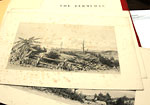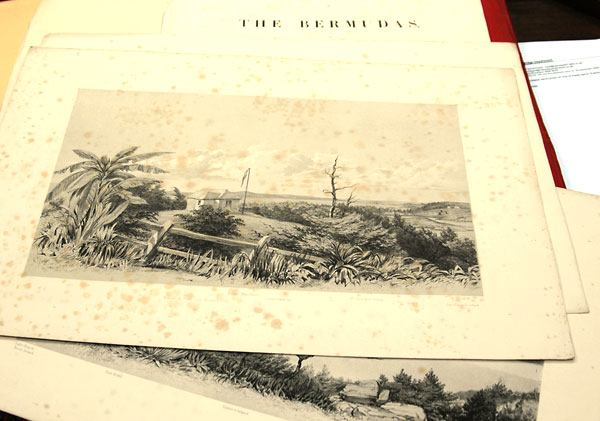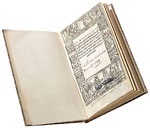Bermuda Shores
Rare Set of Panoramic Lithographs, Holloways of Banbury, £12,075
In years gone past, someone might conceivably have picked up a bargain, but with the advent of the internet, sleepers are awoken far more frequently. Views of the Bermudas or Somers Islands is an exceedingly rare and much coveted portfolio collection of lithographed views. Individual plates might turn up from time to time, I suppose, but the complete set is something a collector might hope to see only once in a lifetime. A few hearts may therefore have skipped a beat when the catalogue for a December 2 sale held by Holloways of Banbury revealed a copy carrying an estimate of just £70-100.
Published in London in 1848, the work comprises 13 litho plates by W. Parrott after Edmund Gilling Hallewell, a young officer who, when posted to the British garrison in Bermuda, did his career no harm at all by wooing and wedding the governor’s daughter, Sophia. It was probably at his father-in-law’s encouragement that his watercolour panoramas were produced. Colonel Reid was keen to see the agricultural and commercial development of the islands and forwarded Hallewell’s finished drawings to the Colonial Office in London, to “convey to persons interested an idea of the nature of this singular group of islands and harbours.”
The unusual number of plates initially led the saleroom to think that it may have been incomplete. But complete it was and these 13 plates actually make up three panoramas of the islands from different vantage points. The Banbury copy was uncoloured and there was quite a lot of foxing to take into account as well, but while condition was undoubtedly a concern for some prospective purchasers, those defects had to be balanced against real rarity.
A Bermudan website dealing with painters who have worked on the islands reckons only eight to 10 sets are currently in private ownership there. Book auction records for the last 30 or so years show only two other copies—an incomplete and presumably uncoloured copy sold for a modest sum in 1981, and a complete coloured copy, the plates all mounted on card, that made £16,500 at Sotheby’s in 1986.
At the Banbury sale there was talk of a coloured set that had made almost twice that sum, but no hard facts. However, such things sometimes turn up in topographical picture or print sales and, with the help of the Sotheby’s print department, I was able to track down that higher priced set. In fact, it proved to be the same one. Sold in 1986 as from the castle library of the Earl of Berkeley, it had come back to Sotheby’s in October 1990, where, in a print sale this time, it was catalogued as the property of “A Gentleman, of Bermuda and Kent.” On that occasion it sold at £30,800 (then $52,670), and it would seem that there has been nothing at auction, coloured or plain, since that time.
The uncoloured and foxed Holloways copy, which came from a local, Oxfordshire estate with no other obvious connections with the Bermudas, was sold to a dealer in the room at £12,075 ($17,990).
The World is Round
Historic Account of Magellan’s Voyage, Ketterer Kunst, Euros 114,000
Fernão de Magalhães, or Ferdinand Magellan as we tend to call him in the English speaking world, did not survive the first circumnavigation of the globe. He met his end in the Philippines. Yet his name defines the remarkable voyage, accomplished without charts and with few navigational instruments, that proved once and for all that the earth was round, established its circumference and the length of a degree of latitude and proved what Phileas Fogg forgot, that a calendar day is lost in circling the globe westwards.
The definitive eyewitness account is the journal of one of those few who survived the voyage, Antonio Pigafetta, but his journal did not appear until 1525 and first printed news of this historic voyage came in a letter written two years earlier by Maximilian of Transylvania. It is now very hard indeed to find, but a November 17-18 sale held by Ketterer Kunst of Hamburg saw a first edition sold for Euros 114,000 ($143,640).
The natural son of an Archbishop of Salzburg, and attached at the time to court of Holy Roman Emperor in Castille, Maximilian had for a tutor that great chronicler of early Spanish voyages to the new world, Pietro Martire d’Anghiera, or Peter Martyr. It was he who sent Maximilian to interview Sebastien del Cano and the 18 other surviving crew members (of an original complement of 234) of the Vittoria – itself the only one of five ships that had set out from Seville in August 1519 that had succeeded in getting home.
What Maximilian learned from these survivors was published in the form of a 15-page letter addressed to his father and three editions of his De Moluccis insulis... were published in Cologne and Rome in 1523. There is some argument as to precedence, but the edition issued in Cologne in January by Eucharius Cervicornus—seen in this Hamburg sale—is reckoned the first.
In recent decades only one other copy of this edition has come to auction—a copy sold for DKr 1.7m (then around $300,000) in 2006 by Rasmussen of Copenhagen.
Sci-Fi Star
Stapledon’s History of the Universe, Bloomsbury Auctions, £1,920
Olaf Stapledon was a teacher, pacifist and philosopher who sometimes employed fiction, and especially science fiction, to bring his ideas to a wider audience. Star Maker of 1937, an outline history of the universe, is regarded by many as his greatest work and in concept at least must be seen as a sci-fi classic. It has been acclaimed as a “mind-boggling, imaginative tour de force,” and as “a prodigious novel” by no less a figure than Jorge Luis Borges.
It was from this 1930s work that physicist and mathematician Freeman Dyson got his idea for the hypothetical mega-structures known as “Dyson Spheres.” As good old Wikipedia explains, such a sphere would be a system of orbiting solar power satellites meant to completely encompass a star and capture most or all of its energy output. Dyson speculated that such structures would be the logical consequence of the long-term survival and escalating energy needs of a technological civilization, and proposed that searching for evidence of the existence of such structures might lead to the detection of advanced intelligent extraterrestrial life.
A very good copy of Star Maker, seen at Bloomsbury Auctions in London on December 11, sold for £1,920 ($2,925). This could well be an auction record for any of Stapledon’s works, but falls short of the sums currently being asked online for firsts in dust jacket.








 Ian McKay’s weekly column in Antiques Trade Gazette has been running for more than 30 years.
Ian McKay’s weekly column in Antiques Trade Gazette has been running for more than 30 years.




